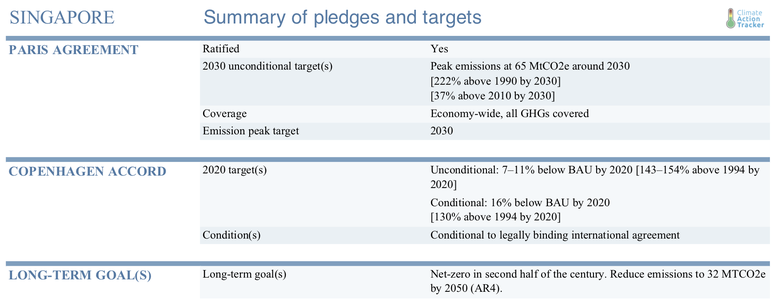Pledges And Targets
Summary Table

Paris Agreement targets
Singapore updated its NDC in March 2020, formalising its first NDC intensity target in absolute terms, as 65 MtCO2e in 2030 (Singapore government, 2020). Its first NDC target was a reduction of emissions intensity of GDP by 36% below 2005 levels (0.176 gCO2e/SGD as specified in the NDC) by 2030 and stabilising emissions, aiming for them to peak around 65 MtCO2e in 2030 (Singapore Government, 2015). The NDC update reframes the commitment from an emissions intensity target to an absolute target and is a good structural change, but does not result in a stronger target compared to the first NDC.
Other updates to the target include using updated IPCC reporting guidelines with more recent IPCC estimates to calculate emissions and improved transparency by including NF3 in the coverage of gases.
Given the stabilisation levels in the first NDC are reported in accordance with the IPCC Second Assessment Report Global Warming Potentials (SAR GWP), and the stabilisation levels in the Updated NDC are reported in accordance with the IPCC Fifth Assessment Global Warming Potentials (AR5 GWP), the Climate Action Tracker estimated the equivalent stabilisations levels in Fourth Assessment Global Warming Potentials (AR4 GWP) to allow for country comparison across Climate Action Tracker country assessments. The Climate Action Tracker update of GWPs in the NDC has not resulted in a difference in Singapore’s level of ambition.
The implicit assumptions about GDP in 2030 vary between the first NDC and the updated NDC. The targets are both intended to lead to a 36% reduction in emissions intensity in 2005 levels. However, as the updated NDC differs in terms of moving to AR5 GWP and including NF3 as an additional gas, GDP assumptions must have changed for the targets to both lead to a 36% reduction, highlighting how unclear and problematic emissions intensity targets can be.
Setting an absolute target is a positive first step. An absolute target provides transparency by setting a concrete level of emissions that will be reached, and do not depend on fluid factors such as GDP. However, this does not replace the need for Singapore to make a more ambitious climate target, substantially scale up climate action, and reduce absolute GHG emissions in the medium term. Thus, Singapore remains in the ‘Highly Insufficient’ CAT rating category.
Singapore is on track to overachieve its updated NDC based on its current policies. If one were to recalculate its updated NDC based on current policies, it would decrease -23% to -26% from 65 MtCO2e to 48-50 MtCO2e in 2030. Therefore, Singapore will need to go beyond this level in order to show a true progression in scaling up climate action.
2020 Pledge
Under the Copenhagen agreement, Singapore committed to reduce its emissions by 7–11% below business-as-usual (BAU) emissions in 2020 unilaterally and, in the event of a legally binding international agreement, by 16% below BAU. The National Climate Change Strategy includes several unconditional mitigation targets for the same year, e.g. a 35% reduction in energy intensity from 2005 levels (National Climate Change Secretariat, 2012).
Of concern is that the BAU pathway provided by the government as reference for the 2020 target assumed the emissions intensity of the economy would go in the opposite direction from the historical trend, increasing significantly until 2020. Despite the fact the emissions intensity of GDP dropped 48% between 2000 and 2010, the BAU pathway assumes a 17% increase between 2010 and 2020.
Long-term goal
In April, the National Climate Change Secretariat (2020) published Singapore’s Long Term Low Emissions Development Strategy (LEDS). The strategy is based on public consultations in mid-2019 (National Climate Change Secretariat, 2019). The LEDS plans to halve emissions from the 2030 peak by 2050, calculated at 32 MtCO2e by 2050 (in AR4 GWP values, reported as 33 MtCO2e in AR5 GWP values), and reach net-zero emissions “as soon as is viable” in the second half of the century (National Climate Change Secretariat, 2020).
Further analysis
Latest publications
Stay informed
Subscribe to our newsletter




